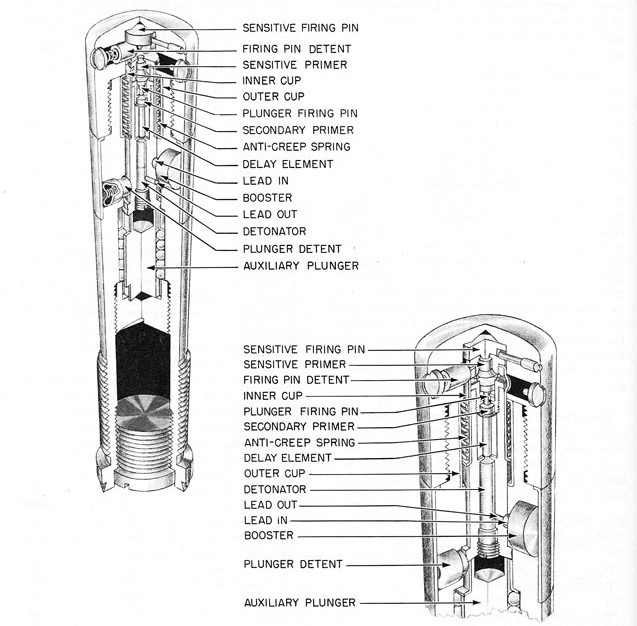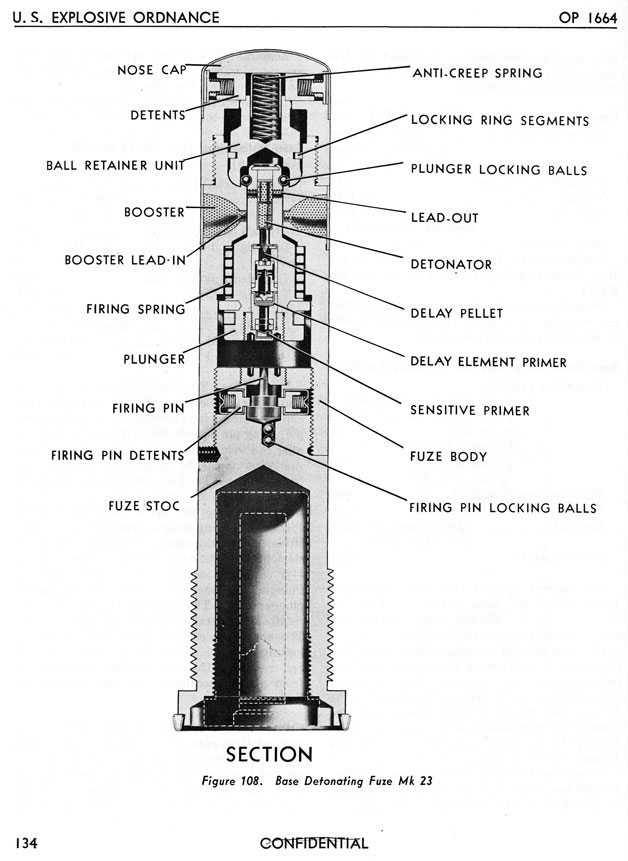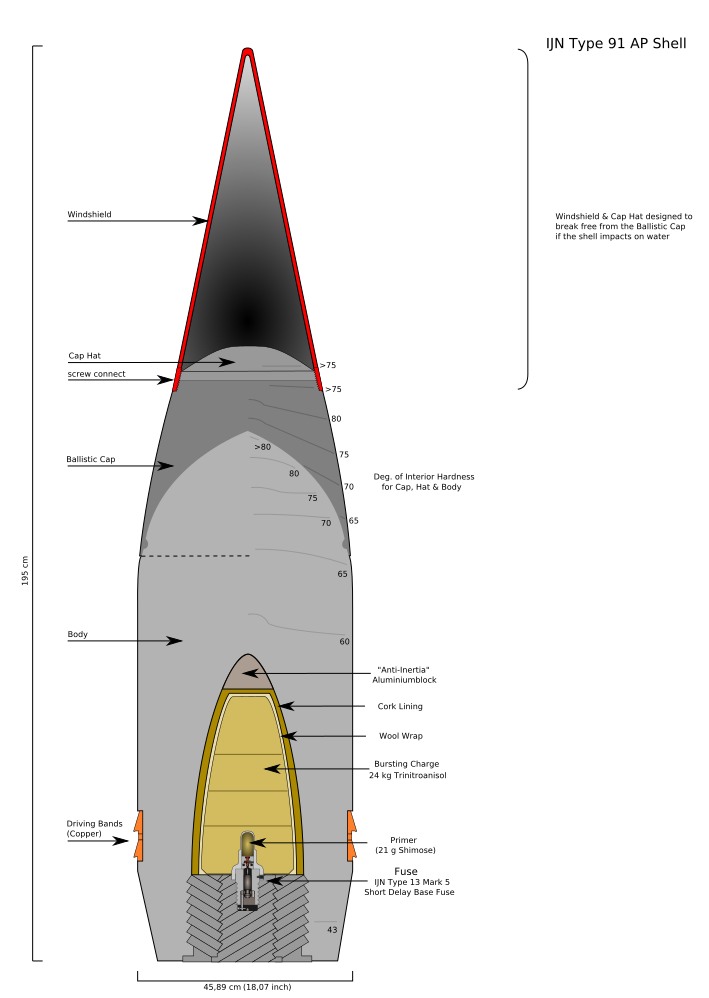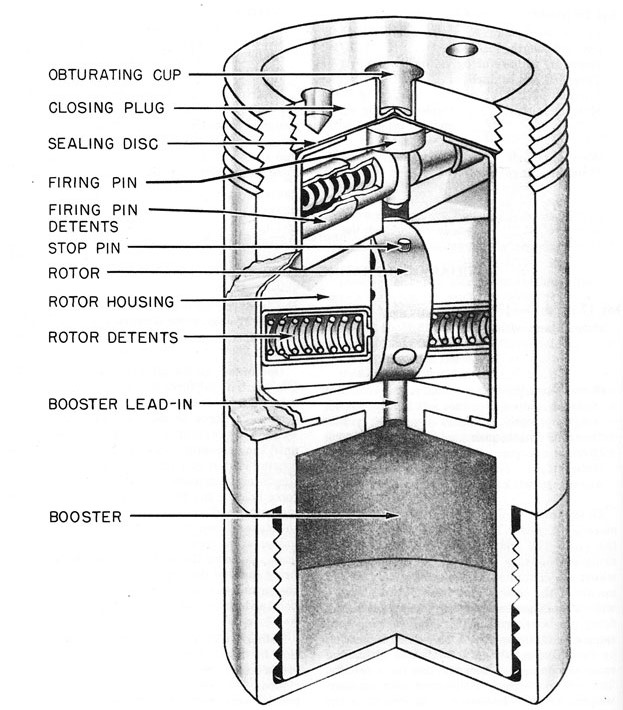With the development of the delay impact fuze, the basic form of fuzing for AP shells was set, and a number of nations appear to have simply gotten fuzes they liked in the early to mid 20s and then stopped developing them. The major exception was the US, always paranoid about things that might go boom. Pretty much all US fuzes1 had at least two if not three independent mechanisms for making sure that nothing went boom before it was supposed to.

A standard USN base fuze
The standard US base fuze (which came in several Mk variants depending on the caliber of the shell, the main difference being the length of the fuze delay) was a complicated device, carefully designed to not arm until the right moment and as a result baffling in its complexity. There were the usual safety pins pulled out by centrifugal force, some of which were held in place while the shell was still in the barrel because setback pushed the sensitive firing pin onto them. The impact force pushed the fuze plunger forward, aligning the holes through which the detonator's flash would pass into the booster and bringing the sensitive primer onto the sensitive firing pin and setting it off. Instead of directly setting off the delay element, the gas from the sensitive primer locked the plunger in the forward position (thus ensuring that the holes would remain aligned even while the delay was burning) and freed the secondary firing pin to impact the secondary primer, which in turn set off the delay element. When that had burned (which took between .01 seconds for 6" shells and .035 sec for battleship shells) it set off the detonator. Some of this complexity was probably to improve fuze reliability during oblique impacts, which could otherwise fail to set off a shell because things get pushed out of alignment.2 This fuze worked quite well in general, although it was soon discovered that fumes from the explosive filler of the shells tended to corrode the fuze internals after 6 months or so, a problem ultimately solved by providing a Bakelite coating.

A Mk 23 fuze
But the Mk 21 wasn't the ultimate fuze the USN sought. That honor falls to the Mk 23, which was designed to function on thinner plates and at higher angles. Internally, the Mk 23 was backwards compared to other shells, with the firing pin at the back, held retracted by the usual safety mechanisms. On firing, it would move forward because of creep, and balls would move by centrifugal force to lock it into place. The rest of the fuze mechanism rode on the plunger, which was fitted with an extremely heavy spring. On impact, the safety mechanism keeping it in place would be freed and lock out of the way, while the spring itself would compress. When the acceleration ended, it would be thrown hard against the firing pin, which not only set off the primer but also aligned the holes leading to the booster.3 Unfortunately, this fuze proved unreliable in service, and the USN retired it in favor of the more conventional fuze described above.

A Japanese Type 91 AP shell, optimized for underwater hits
But the failure of the Mk 23 was largely because it didn't find the right home. The nation that struggled most with fuzes during the war was Japan, largely due to their preoccupation with underwater shell hits. Hitting the water would set off most conventional impact fuzes, so a shell with a conventional delay would likely detonate well short of the target. Conversely, getting underwater hits would require an order of magnitude or so more delay than normal. Of course, this meant that if you did score a conventional hit, the shell is very likely to go entirely through the target and out the other side before the fuze goes off, a problem that bedeviled the Japanese throughout the war. The Mk 23, because it was set up to go off at the end of the deceleration, would have been equally effective in either case, but the only change to Japanese impact fuzes after the mid-20s was longer delays, a great boon to Allied navies.

An Auxiliary Detonating Fuze
One last fuzing issue deserves mention here, the Auxiliary Detonating Fuze (ADF), a product of the American mania for explosive safety. This was installed below the nose fuze in shells that could accept one, and was intended to improve safety in case the shell was dropped on its nose. The basic idea was that the ADF, armed by centrifugal force, would transmit the detonation from the nose fuze into the explosive filler, but would otherwise remain inert. Unfortunately, they only performed part of this function. While they generally kept shells safe when not fired (with the notable exception of the disaster aboard Newport News in 1972), tests discovered that if the nose fuze was replaced by a metal plug so that the delay base fuze took over, the shock of hitting a steel plate would set off the ADF anyway. Unfortunately, there was no way to remove an ADF without disassembling the entire shell, so they generally stayed around, except for a few 8" common shells that were modified to only have a base fuze.
But one major issue in interwar and wartime fuzing has been neglected here. Shooting at aircraft obviously required different fuzing from surface targets, and that will be our topic next time.
For more details on fuzing in this era, see here, here, here and here.
2 This was not a new idea, and there were mechanisms intended to do this dating back well before WWI, although they were often discarded to reduce cost. ⇑
3 An earlier version of this fuze mechanism, the Mk 11, included a clever mechanism to automatically tailor the delay to the type of target. A tube would be embedded in the delay element by the deceleration, with longer deceleration (and thus probably a bigger, heavier target) embedding it deeper. The flash to ignite the delay element would go down this tube, so a deeper tube meant a longer delay. This mechanism was even less reliable, and was removed when the fuze was reworked as the Mk 23. ⇑

Comments
Was there any substantial difference in safety between the different nations when it came to fuzes in this era? Did the USN get anything extra from its additional investment?
It's not entirely clear (small sample sizes and all), but I believe the USN did get some advantage.